Team Management
Overview
Team Management is used in Sugar to define permissions and groupings for users. These permissions cover what records a user is and is not able to access. Teams are used in conjunction with Roles to form a robust security model for non-admin users in Sugar. Users can use team settings on specific records to allow different users within Sugar the option to view these given records. Team settings can also be used as a form of organization, thereby separating records to be associated with specific teams for better tracking. Teams can be based on departments, geographic regions, or whatever else works best in a given organization.
Note: For SugarIdentity-enabled instances, the administrator can grant regular users "Admin & Developer" access to Users, Teams, and Roles in Sugar as well as access to SugarIdentity to manage certain user data (e.g., name, email address) and perform certain actions without having full system administrator access. For more information on configuring and assigning this role to users, refer to the SugarIdentity Guide.
Teams Module Tab
Click the Teams module tab in the navigation bar, shown after selecting Team Management in the Admin page, to access the Teams list view. You may also click the three-dots menu in the Teams module tab to display the Actions and Recently Viewed menus. The Actions menu allows you to perform important actions within the module. The Recently Viewed menu displays the list of teams you last viewed in the module. 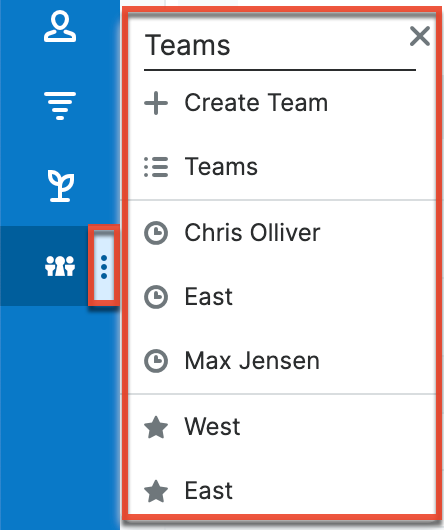
| Menu Item | Description |
| Create Team | Opens the edit view to create a new team. |
| Teams | Opens the list view layout to search and display teams. |
Team Types
From an administrative standpoint, teams will be handled differently based on their types. From a user standpoint, all teams will be treated pretty much the same. Each team type has their own special set of characteristics that aid in defining it. The team types defined as:
The Global Team
The Global team is created automatically when a Sugar instance is created. Global is the default team for all new users, and every user is a member of the team by default. Global is a universal team, so any records associated to the global team will be viewable by the users on this team. The global team is intended to be available for all users and a shared team for all users in Sugar.
Note: You cannot delete the Global team.
Standard Teams
Standard Teams can be created by administrators via Team Management. These are to be used throughout Sugar to organize and grant access on organizational specifics to your organization. Standard teams are often broken out into groups by departments, geographical regions, or duties. For example, you may have an East and West team, and also a Sales and Support team.
Private Teams
For every user that is created in Sugar, a corresponding private team is automatically created in the Teams module. By default, the private team name is the user's first and last name. A private team name will be updated any time the corresponding user's profile is edited and re-saved, even if the change was not made to the user's first or last name. For example, the private team for Jane Smith will be automatically named "Jane Smith". If the administrator edits private team "Jane Smith" to "Jane Smith-HR", and then user Jane Smith later updates the phone number on her user profile, Sugar will revert the private team name back to the user's first and last name, "Jane Smith".
If your organization plans to edit private team names, you must disable the automatic update feature. Navigate to Admin > System Settings and select the checkbox next to "Prevent private team names from inheriting the user's name fields". For more information on this setting, please refer to the System documentation.
Note: Private teams are not deleted in the same method as other teams. For more information on deleting private teams, please review the Deleting Teams section of this guide.
Team Membership Types
Team memberships are given to users in one of two ways, either by an explicit or implicit membership. Regardless of the type, membership will control what records regular users are able to see. Each membership can be granted in different ways and can constitute different functionality. Team membership is represented in the team's detail view, as well as the user's record view.
Note: Administrators do not adhere to team security and therefore can see all records.
Explicit team membership is forged when the relationship is defined from either the team's or user's record view. In addition, explicit relationships are also represented with private team memberships. Explicit memberships, other than private teams, can be removed as necessary from the team's or user's record view. Explicit memberships will also include membership functionality for actions such as workflows, SugarBPM processes, and inbound email.
Implicit team membership is used for record visibility. Implicit membership relies on the "Reports To" field in the User Profile. When one user reports to another, the hierarchy of the "Reports To" field is kept intact. The user being reported to will inherit the team membership of the subordinate user and be able to see any records on both his or her own team, and the teams of which the subordinate user is a member. The subordinate's teams can either be explicit or implicit teams in this scenario.
Note: Implicit relationships cannot be removed, but the cause for their relationship can be broken by changing the reporting hierarchy.
In the Team's detail view, the user's subpanel will showcase which relationships are explicit and which are implicit. In the "Membership" column of the Users subpanel, the user will either be marked as a "Member", meaning that they are an explicit member, or "Member Reports-to", meaning they are an implicit member. In addition, the users marked with the "Member Reports-to" will not include an "Unlink" button, as they have another user (or users) reporting to them on this team.
Creating Teams
There are two methods that can be used to create teams in Sugar. These are via the Teams module tab's action list or by duplicating an existing team and then editing it. After initially creating the team, the administrator will need to associate users to the newly created team. For information on creating Private Teams, please review the Repairing Teams section of this documentation.
Note: For instances that use SugarIdentity, administrators have the ability to log in as other users in their organization using the "Impersonate (Log in as)" option in SugarIdentity. So, after associating users to the appropriate teams, you can preview the user's account via impersonation to ensure that the proper permissions are in place. For more information on impersonating a user, refer to the SugarIdentity Guide.
Creating Via Teams Module
The most common way to create a new team is via the Create Team option in the Teams module tab. This opens up the edit view layout which allows you to enter in all the relevant information for the team.
Use the following steps to create a team via the Teams module:
- Navigate to Admin > Team Management.
Note: The Teams list view will open displaying all existing teams that are currently available. - Click the three-dots menu in the Teams module tab and select "Create Team".
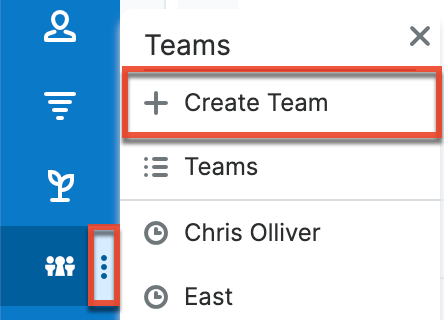
- Enter a name and description of the team on the edit view screen that you are now presented with. Enter the appropriate values for fields in the edit view layout. All required fields are marked with a red asterisk and must be completed prior to saving.
- On the team's detail view, add users that are members of this team.
Creating Via Duplication
You can also create a new team by duplicating an existing team. The Copy option is useful if the team you are creating has a similar set of members or a similar description to an existing team
Use the following steps to create a team by duplicating an existing record:
- Navigate to a team record's detail view.
- Click the Actions menu and select "Copy".
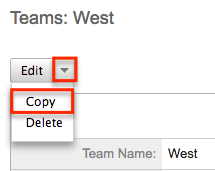
- The displayed edit view is pre-populated with the original team's values. Update the name field, and description if need be, then click "Save".
- On the team's detail view, add any users that are members of this team that are not on the original team, and remove any unwanted users.
Adding Users to Teams Via Teams Module
A user has to be associated to a team to be able to view records that are associated to the specific team. Assigning a team is much like any other many-to-many relationship in Sugar, where many users can be associated to one particular team, and one user can also be assigned to multiple teams. From Team Management, a user can be associated to a team via the Users subpanel at the bottom of the detail view. To associate users to a team, follow the following steps:
- Navigate to Admin > Team Management.
- From the Teams list view, select the team that you are working with.
- At the bottom of the page, click "Select User" from the Users subpanel

- Use the popup search menu to search for and select the user(s) you would like to add to this team where you can either click on the user's name or, if selecting multiple users, click their corresponding checkboxes and then click "Select".
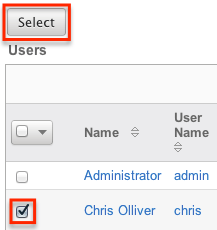
- After selecting the user(s) the popup search box will close and the user(s) will now be displayed in the Users subpanel for the team to complete the relationship.
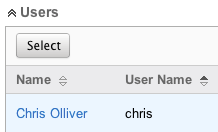
Adding Users to Teams Via Users Module
A regular user must be associated to a team to be able to view records that are associated to that team. Assigning a team is much like any other many-to-many relationship in Sugar, where many users can be associated to one particular team, and one user can also be assigned to multiple teams. From User Management, a user can be associated to a team via the user's record view. For more information on User Management, please refer to the User Management documentation. To associate a team to a user via User Management, follow the following steps:
- Navigate to Admin > User Management.
- From the Users list view, open the user record that you would like to edit.
- Scroll to the Teams subpanel, click the triangle to the right of the Add button, then select "Link Existing Record".

- Use the drawer to search for and select the team(s) you would like to add to this user where you can either click on the team's name or their corresponding checkboxes and then click "Add".
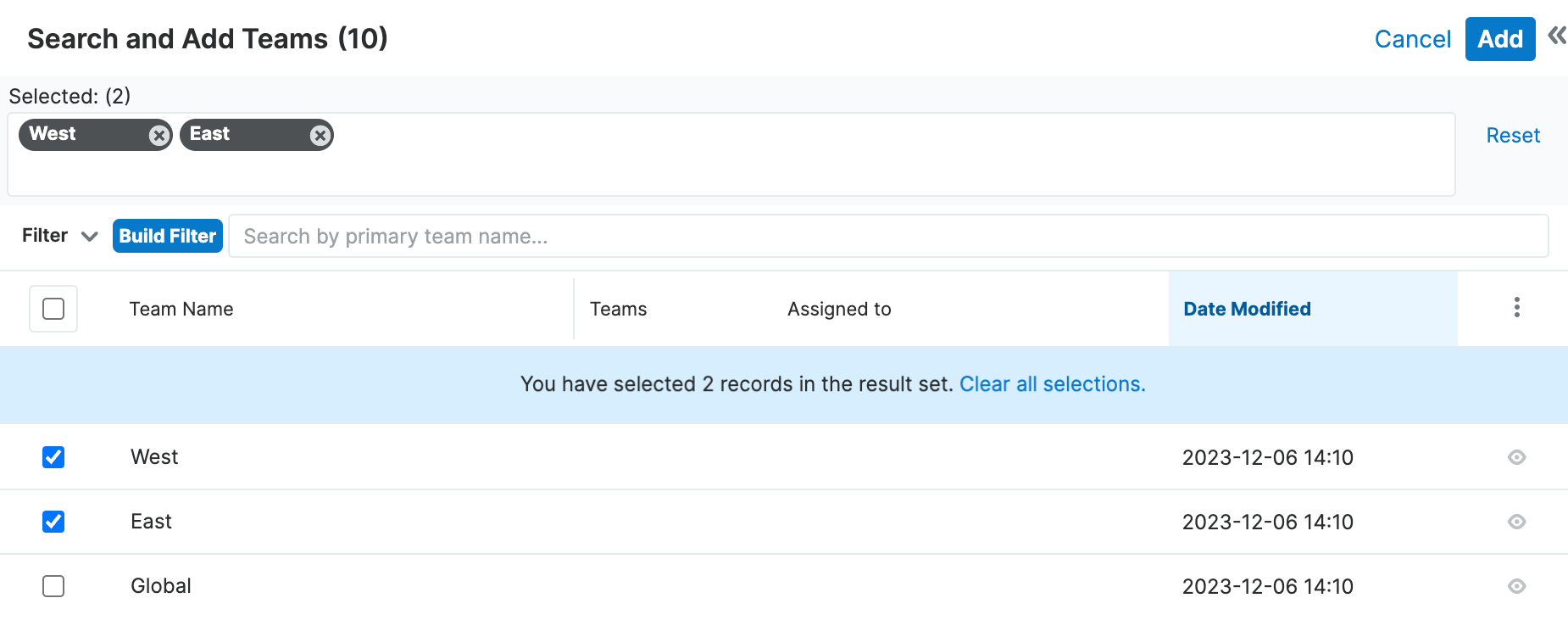
- After adding the team(s) the drawer will close and the team(s) will be displayed in the Teams subpanel for the user.
Viewing Teams
There are various options available for viewing team records in Sugar including via the Teams list view, Teams detail view, Teams Last Viewed menu, from dashlets, and from reports.Viewing Via List View
The Teams list view displays all team records meeting the current search criteria. To access the list view, simply navigate to Admin > Team Management. Alternately, if you are looking at a team's detail view, you can click the Teams module tab to return to the list view. You can click the team's name to open the record in detail view. For more information on viewing teams via list view, please refer to the Teams List View section of this documentation.Viewing Via Detail View
The Teams detail view displays thorough team information showing the name and description of the team, followed by a subpanel of the users associated to the team. The detail view can be reached by clicking a team's link from anywhere in the application including from the Teams list view. For more information on viewing teams via detail view, please refer to the Teams Detail View section.
Viewing Via Recently Viewed
As you access different teams, Sugar will keep track of which teams you have recently viewed. Click the three-dots menu in the Teams module tab to see a list of the 3 records you most recently viewed in the module. Clicking the record's name within the list will open it in detail view.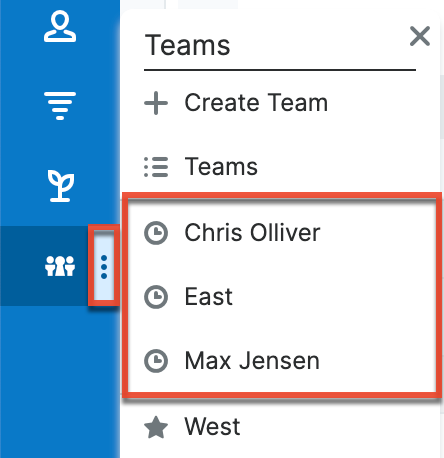
Viewing Via Dashlets
The Home page displays a collection of Sugar Dashlets which allow users to get a quick view of various records, activities, reports, etc. You can view team information in most module-specific dashlets. Clicking a team's name from any dashlet will open the team in detail view. For more information on using dashlets, please refer to the Dashlets section of the Home documentation.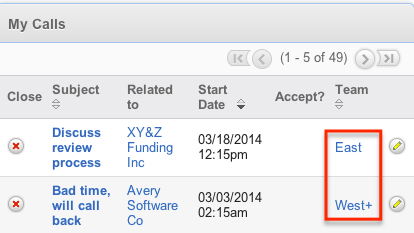
Viewing Via Reports
Administrators have the option to build, run, and manage reports to gather key data from records within Sugar. When building a report, there are options to either run the report from the Teams module or add links to teams related to the records that are being reported on. Once the report is run, you will be able to view the team record's detail view by clicking the team's name in the report results. Please note that you can only directly access team detail views with Rows and Columns and Summation with Details-type reports as Summation and Matrix-type reports do not include hyperlinks in their display columns. For more information on using reports, please refer to the Reports documentation.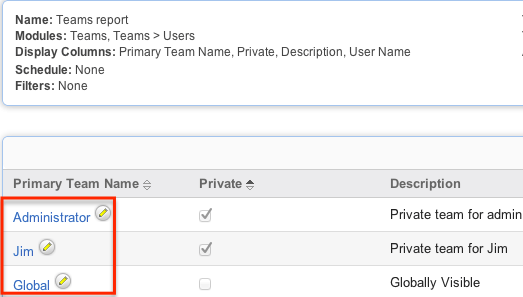
Searching Teams
The Teams list view search function searches for the name of the team to help you locate records easily and effectively. Once the search is performed, the relevant results will be displayed in the Teams list view below.
The buttons in the search panel have the following functions:
- Search: Click the Search button or press your Return/Enter key to perform the search.
- Clear: Click the Clear button to clear all criteria from the searchable fields.
To see all Team records, simply click "Clear" and then "Search" to perform a blank search with no name filter.
Please note that Sugar automatically appends the wildcard character (%) to the end of your search phrase. This allows the system to retrieve all records that start with the keyword entered in the search. If you would like to broaden the search, you can use the wildcard at the beginning of your text as well (e.g., %Administrator). This will pull up any record that has the word "administrator" in the name, regardless of how it starts or ends.
For more information on using the various search methods as well as how wildcards are used, please refer to the Search documentation.
Teams List View
The Teams list view displays all teams meeting the current search criteria, if any. You can view the name and description of each team within the field columns. Click on the name of the team to access the detail view for the team and review the settings further.Pagination
List view displays the current search results broken into pages that you can scroll through rather than displaying potentially thousands of rows at once. To the right just below the search panel you can see which records of the total results set are currently being displayed. The two single-arrow Next and Previous buttons can be used to scroll through the records page-by-page. The two double-arrow First Page and Last Page buttons allow you to skip to the beginning or the end of your current results.
By default, Sugar displays 20 records per list view page, but administrators can change the number of records displayed via Admin > System Settings. For more information on changing the number of displayed records, please refer to the System documentation in the Administration guide.
Checkbox Selection
Teams can be deleted in a mass-delete fashion via the list view by selecting all of the team records. To select individual team records on the Teams list view, mark the checkbox on the left of each row. To select or deselect multiple teams on the list view, use the options in the checkbox dropdown menu:
- Select This Page: Selects all records shown on the current page of results
- Select All: Selects all records in the current search results across all pages of results
- Deselect All: Deselects all records that are currently selected
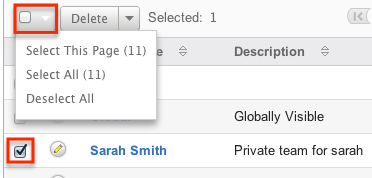
For more information on deleting teams, please refer to the Deleting Teams section of this documentation.
Actions Menu
The Actions menu to the right of the checkbox dropdown allows you to perform various actions on the currently selected records.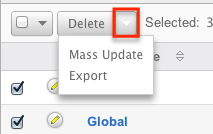
The options in the Actions menu allow you to perform the following operations:
| Menu Item | Description |
| Delete | Delete one or more teams at a time. |
| Mass Update | Mass update one or more teams at a time. |
| Export | Export one or more teams to a CSV file. |
Column Sorting
List view provides the ability to sort all of the current search results by a field column in either ascending or descending order. To sort by a field or switch the sort direction, click the column header for either "Name" or "Description". The list view may be sorted by only one column at a time.

Teams Detail View
The Teams detail view displays thorough information about the team, as well as the ability to perform most actions related to team management. The detail view also includes a Users subpanel where users can be associated to the team and will therefore take on the team's properties.Actions Menu
The Actions menu on the top left of each team's detail view allows you to perform various actions on the current record. Administrator users can change the action items to be displayed as separate buttons instead of a dropdown menu via Admin > System Settings. For more information on configuring the actions menu, please refer to the System documentation in the Administration Guide.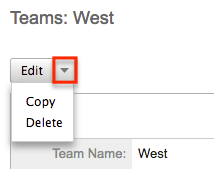
The options in the Actions menu allow you to perform the following operations:
| Menu Item | Description |
| Edit | Edit the name and description of this team. |
| Copy | Duplicate this team to create a new team. |
| Delete | Delete this team. |
Users Subpanel
A user has to be associated to a team to be able to take on the team's membership settings. Assigning a user is much like any other many-to-many relationship in Sugar, where many users can be associated to one particular team, and one user can also be assigned to multiple teams. From Team Management, a user can be associated to a team via the Users subpanel at the bottom of the page. To associate uses to a team, follow the following steps:
- Navigate to the detail view of the team that you would like to edit.
- At the bottom of the page, click "Select User" from the Users subpanel
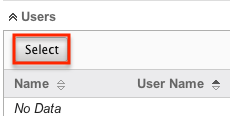
- Use the popup search menu to search for and select the user(s) you would like to add to this team. You can either click on the user's name or, if selecting multiple users, click their corresponding checkbox and then click "Select"
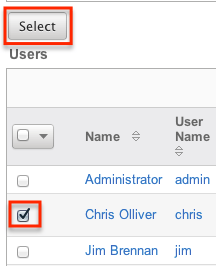
- After selecting the user(s) the popup search box will close and the user(s) will now be displayed in the Users subpanel for the team to complete the relationship

Next or Previous Record
On the upper right of the Teams detail view, there are two buttons that allow you to page through each team in the Teams list view's current search results. Clicking the Previous button displays the previous team of the current search results while clicking the Next button displays the next team of the current search results. The text in between shows which team result you are currently viewing within the total number of current results.
Editing Teams
Teams may be edited at any time to update or add information to the record or to edit existing information. You can make changes to existing team records via the Teams detail view and edit view, or from the Users module. Edit view is available within the Teams module and includes the Name and Detail fields.Editing Via Detail View
You can edit teams via the detail view by clicking the Edit button on the upper left of the page. Once the edit view layout is open, update either the Name or Description fields, then click "Save" to preserve the changes made.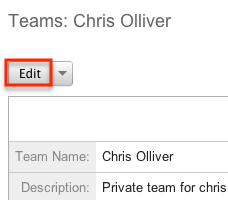
Editing Via List View
You can edit teams via the list view by clicking the Pencil icon to the left of each team's name. After clicking the pencil, the window will move to the edit view. Update the necessary fields, then click "Save" to preserve the changes. After saving from the edit view, you will be returned to the detail view for the record that you just updated. Because this method brings you to the edit view, the Name and Description fields can be updated.
Editing Via Users Module
The Users module allows you to see all of the teams associated with a specific user in one place. The page will show the Teams subpanel with a list of all of the teams associated with the user. For more information about viewing the teams from the Users module, please review the User Management documentation. On the Teams subpanel, there is an option to edit the team name. Clicking the Edit button changes the row to allow inline editing where you can update the team name and then click "Save" to preserve the changes.
Deleting Teams
If a team record is invalid or is no longer being used in your organization's Sugar instance, it may be deleted from either the Teams detail view or list view. Deleting via the detail view allows you to delete a single record while the list view allows for mass deleting multiple records at once. Deleting team records will not delete any related user records and will only remove the relationship.
The exception to this is found when trying to delete any private teams. Private teams are only able to be deleted when the user that the team is for has been deleted. To delete a private team, first delete the user via the user's record view, following the steps from User Management.
Deleting Via Detail View
Use the following steps to delete a team via the detail view:
- Navigate to the team record's detail view.
- Select "Delete" from the Actions menu.
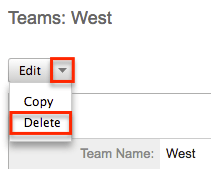
- A pop-up message will display asking for confirmation. Click "Ok" to proceed.
Deleting Via List View
Use the following steps to delete one or more teams via the list view:
- Navigate to the Teams list view by navigating to Admin > Team Management.
- Use the Search functionality to search to find the Team records you wish to delete.
- Select the desired team records individually or using the checkbox dropdown's options.
- Choose "Delete" from the Actions menu.
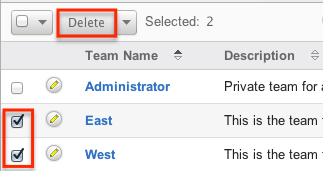
- A pop-up message will display asking for confirmation. Click "Ok" to proceed.
Due to PHP memory limitations on the server, there may be occasions when the application times out while deleting a large number of team records. If you encounter an error when performing this action, we recommend selecting the records in smaller batches.
Removing Users From Teams
Users can be associated to multiple teams, and one team can also be associated to many users. As changes occur within an organization, there may be times that users need to be removed from specific teams. Breaking the relationship between a team and a user can be done both from the Teams detail view and from the Users record view. Both modules include a subpanel to represent the relationship to the other module.
To remove a user from a team, use the following steps:
- Navigate to the team record's detail view.
- Click "unlink" to the right of the user's row.

-
A pop-up message will display asking for confirmation. Click "Ok" to proceed.
To remove a team from a user, use the following steps:
- Navigate to the users' record view.
- Scroll down to the Teams subpanel and identify the team name you wish to remove.
- Click the triangle on the right of the row and select "Unlink" from the Record Actions Menu.
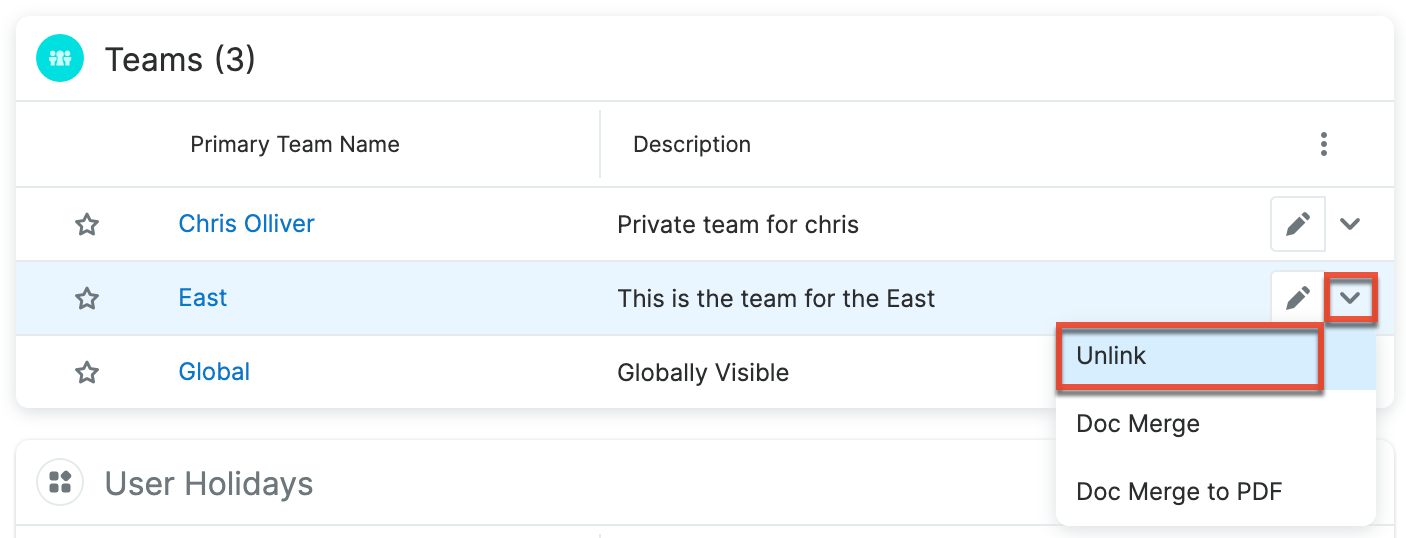
-
A pop-up message will display asking for confirmation. Click "Confirm" to proceed.
Repairing Teams
Sugar's Repair menu includes two options for administrators to improve team structures and functionality. These processes should not be needed often, and are only used when the necessary changes are to be made. The repair options are as follows:
| Type | Description |
| Upgrade Teams | Checks to make sure that all users have associated private teams. |
| Repair Teams | A combination of four different repair functions to rebuild team accesses. |